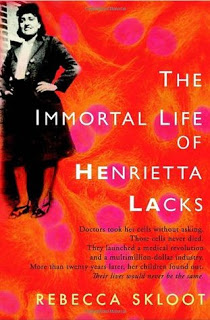THE IMMORTAL LIFE
OF HENRIETTA LACKS
By: Rebecca Skloot
Published: February 2, 2010
Non-Fiction
Her name was Henrietta Lacks, but scientists know her as HeLa. She was a poor Southern tobacco farmer who worked the same land as her slave ancestors, yet her cells—taken without her knowledge—became one of the most important tools in medicine. The first “immortal” human cells grown in culture, they are still alive today, though she has been dead for more than sixty years. If you could pile all HeLa cells ever grown onto a scale, they’d weigh more than 50 million metric tons—as much as a hundred Empire State Buildings. HeLa cells were vital for developing the polio vaccine; uncovered secrets of cancer, viruses, and the atom bomb’s effects; helped lead to important advances like in vitro fertilization, cloning, and gene mapping; and have been bought and sold by the billions.
Yet Henrietta Lacks remains virtually unknown, buried in an unmarked grave.
Now Rebecca Skloot takes us on an extraordinary journey, from the “colored” ward of Johns Hopkins Hospital in the 1950s to stark white laboratories with freezers full of HeLa cells; from Henrietta’s small, dying hometown of Clover, Virginia—a land of wooden slave quarters, faith healings, and voodoo—to East Baltimore today, where her children and grandchildren live and struggle with the legacy of her cells.
Henrietta’s family did not learn of her “immortality” until more than twenty years after her death, when scientists investigating HeLa began using her husband and children in research without informed consent. And though the cells had launched a multimillion-dollar industry that sells human biological materials, her family never saw any of the profits. As Rebecca Skloot so brilliantly shows, the story of the Lacks family—past and present—is inextricably connected to the dark history of experimentation on African Americans, the birth of bioethics, and the legal battles over whether we control the stuff we are made of.
Over the decade it took to uncover this story, Rebecca became enmeshed in the lives of the Lacks family—especially Henrietta’s daughter Deborah, who was devastated to learn about her mother’s cells. She was consumed with questions: Had scientists cloned her mother? Did it hurt her when researchers infected her cells with viruses and shot them into space? What happened to her sister, Elsie, who died in a mental institution at the age of fifteen? And if her mother was so important to medicine, why couldn’t her children afford health insurance?
This was our Book Club Read for the month of November and I am very anxious to discuss it this evening. I was so excited we could get this book (we get all our books through inter-library-loan, so newer/popular books are hard to get) as I had been wanting to read it for awhile.
Even though this book is labeled non-fiction, most of the story read like a novel. Skloot took great care to tell the story of Henrietta and her family and then tell the story of the cells using words and descriptions for the lay-person. I never once got bored reading through the scientific part of the book, but was instead incredibly fascinated. Throughout most of the book, I know my mouth was hanging open as I was in shock at the things that were happening to Henrietta and her family.
I found the beginning of the story very fascinating because Henrietta died in 1951, just a few years before my own grandmother died of ovarian cancer. Even though the 1950’s doesn’t seem that far away, the world in relation to other races and the medical world were much different that what they are today. So much has progressed and changed it is hard to take it all in. I think of my mom and her sisters and wonder if they had much of the same feelings Deborah, Henrietta’s daughter, had about missing her mom. I think of my grandma and wonder how she managed her feelings of despair and fear after finding out her diagnosis, knowing she was leaving 5 daughters behind.
There was so much to learn about cancer, cells, and medical research that I feel like I could continue to read on this subject forever. Even since this was written in 2009, I wonder how much has changed or progressed just since then.
I appreciate that Skloot has set up a scholarship fund for the decendents of Henrietta and that many of them are going on to college – even in the science field. They are the ones that can change the course of their family’s history and make a difference in their own right.
I can’t stress enough that this book should be read. As a woman, as a mother, as someone who receives medical care – this book has opened my eyes and has given me a new appreciation for the research and advances in medical care that we have seen and will continue to see in our lives.
Posted Under African-American, biography, book club, Book Review, historical non fiction, Rebecca Skloot

